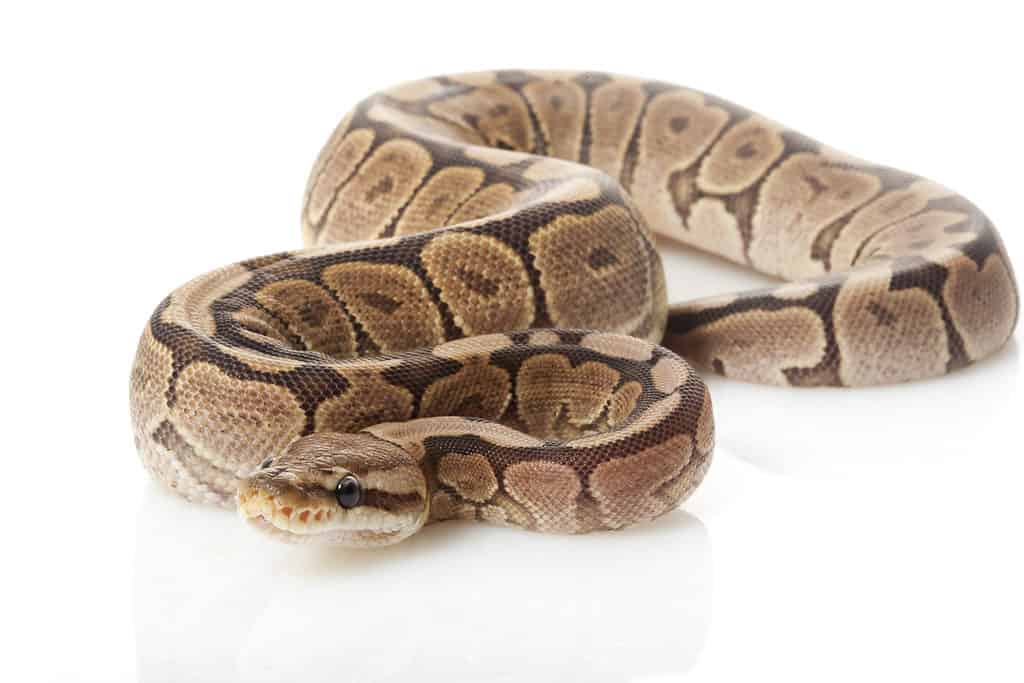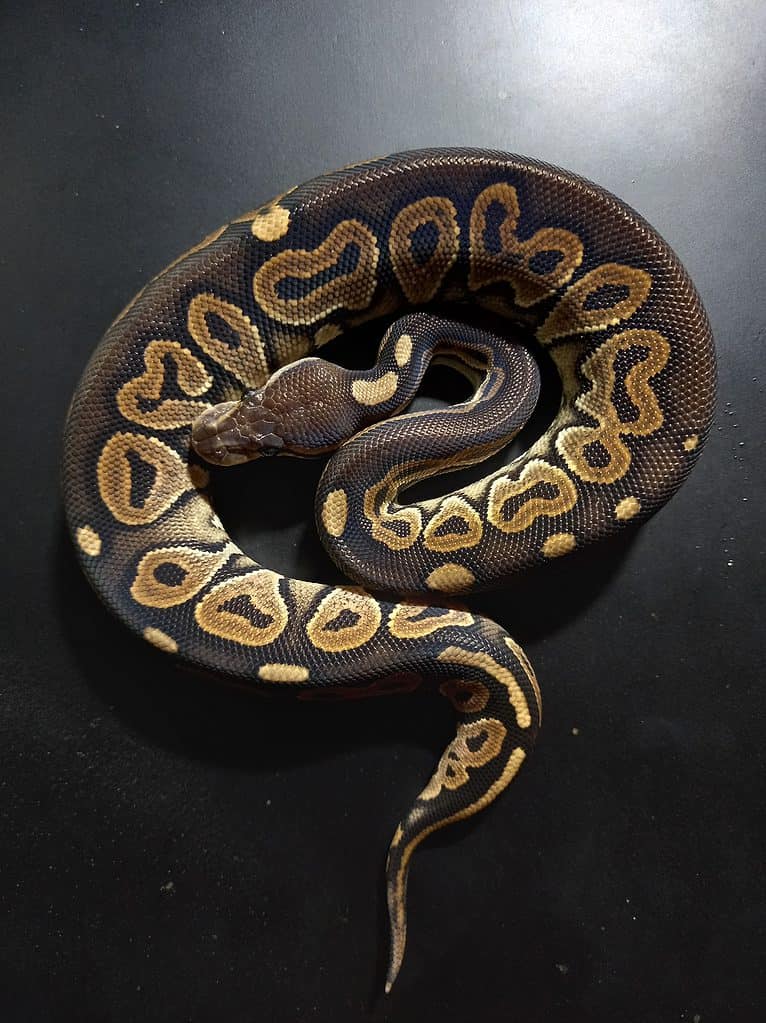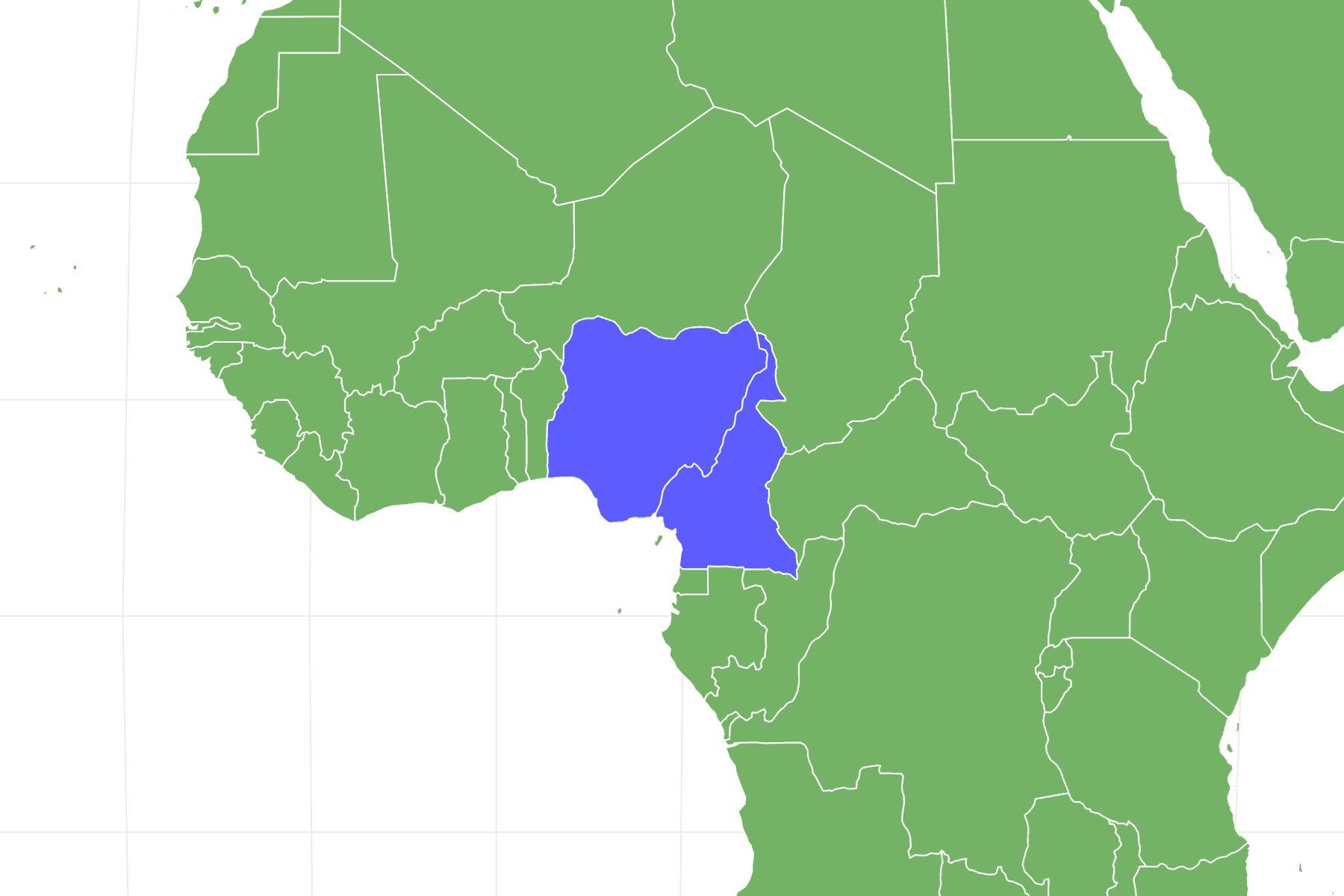Cinnamon Ball Python
Python regius
Advertisement
Cinnamon Ball Python Scientific Classification
- Kingdom
- Animalia
- Phylum
- Chordata
- Class
- Reptilia
- Order
- Squamata
- Family
- Pythonidae
- Genus
- Python
- Scientific Name
- Python regius
Read our Complete Guide to Classification of Animals.
Cinnamon Ball Python Conservation Status
Cinnamon Ball Python Facts
- Prey
- Rodents, birds, amphibians, fish
- Main Prey
- Small rodents
- Group Behavior
- Solitary
- Most Distinctive Feature
- Reddish body color and keyhole patterning
- Temperament
- Docile, curious, hardy
View all of the Cinnamon Ball Python images!
“The cinnamon ball python morph is best known for its warm, reddish-brown coloration and keyhole-shaped markings.”
Cinnamon Ball Python Summary
First produced in 2002 by Graziani Reptiles, Inc. in Venus, Florida, the cinnamon trait modifies an affected ball python’s coloration and pattern. Originally, the morph was named cinnamon pastel. However, its founding breeder, Greg Graziani, later shortened its name to cinnamon to more clearly differentiate it from the already-existing black and pastel morphs.
The cinnamon morph’s name suits it well, as it is primarily reddish-brown with very little yellow or gold tones. It also has large, rounded “keyhole” or roughly bullseye-shaped markings. These markings have smaller round brown or black spots inside them in a roughly concentric pattern. This patterning differs significantly from the typical “alien head”, or banded pattern of most ball python morphs.
In more recent years, many reptile breeders have combined the cinnamon trait with other traits to create new designer morphs, such as the banana cinnamon, cinnamon pinstripe, and black pastel cinnamon varieties.
4 Amazing Cinnamon Ball Python Facts!
- The cinnamon morph has almost no yellow or golden tones, resulting in a mostly reddish-brown snake with light beige and dark brown accents.
- The unique “keyhole” patterning of the cinnamon morph is also present in several other morphs, such as the Mojave. Rather than having large splotches with two smaller dots in them like the usual “alien head” pattern, its keyhole or roughly bullseye-shaped markings have a single dark brown spot in the center.
- The cinnamon morph’s founder, Graziani Reptiles, Inc., also helped create the pastel morph in 1994.
- The cinnamon morph is a single-trait, incomplete dominant base morph, meaning it can actually occur in the wild. Unfortunately, there are virtually no documented instances of wild cinnamon ball pythons.
Where to Find Cinnamon Ball Pythons
The cinnamon ball python has now existed for more than two decades, and it has become increasingly common in the reptile trade over the years. Today, many breeders all around the world have created cinnamon lines of their own, making the morph fairly affordable and easily accessible from marketplaces like MorphMarket.
If you are planning on purchasing a cinnamon ball python, you’ll likely end up paying around $80 to $150 per snake. Be aware, however, that this price can increase if you are looking for a morph with additional traits, like the banana cinnamon or cinnamon clown. These designer morphs with two or more traits are more complicated and time-consuming to breed and thus often cost significantly more.
The regular, wild-type ball python is native to western and central Africa, mostly within the Sub-Saharan area. Base morphs with a single trait like the cinnamon variety can be born in the wild naturally, but this is incredibly rare.
Cinnamon Ball Python Scientific Name
The ball python’s scientific name is Python regius, meaning it is a member of the Pythonidae family. Notably, it is one of the smallest and most well-known and studied species within this group.
The species’ taxonomic name has Latin roots and means “royal python.” This refers to how ancient Egyptian royalty would commonly wear live snakes around their wrists and arms as jewelry. The snakes they adorned themselves with were likely baby ball pythons due to their non-aggressive disposition and compact size.
All ball python morphs have the same taxonomic classification and, thus, the same scientific name. Importantly, morphs are not subspecies but rather more akin to specific “breeds” of the same animal.
Cinnamon Ball Python Population and Conservation Status
The IUCN Red List classifies the ball python, Python regius, as near threatened. While it doesn’t currently qualify as endangered or vulnerable, the species’ numbers have been declining slightly throughout its native habitats in recent years. It is unknown precisely how many ball pythons are living in the wild or in captivity.
The main factor causing the ball python’s population to decrease is habitat loss. Many industries contribute to this issue, but Africa’s rapidly expanding agricultural industry is the main party responsible. Additionally, humans catch and remove the snakes from their natural habitat, both for food and for the exotic pet industry.
How to Identify Cinnamon Ball Python: Appearance and Description
The cinnamon trait heavily alters an affected ball python’s pattern and overall coloration. As a result, cinnamon ball pythons have several identifying traits that clearly set them apart from wild-type ball pythons and other morphs.
True to its name, the cinnamon morph has very little yellow or gold tones and is mostly reddish, dark brown, and tan in color. In certain individuals, some of their markings can be almost black. Most cinnamon snakes have dark brown heads with light beige eye stripes and very little blushing–they even lack the typical pale, faded spot in the center on top of the head.
The cinnamon morph’s pattern also differs significantly from the usual “alien-head”, or band-like markings present in most other morphs and standard ball pythons. Instead, it has a “keyhole” pattern with large, rounded brown splotches that each have a single dark brown or black spot in the center.
Finally, cinnamon ball pythons can sometimes experience minor genetic mutations, mainly “duckbill” lips and mild tail kinking. These issues are fairly rare and do not typically require much medical intervention. They are more common in the super cinnamon morph that results from breeding two cinnamon snakes together.
When trying to identify a cinnamon ball python, look for these key traits:
- Reddish tones throughout the entire body with little to no gold or yellow colors
- “Keyhole” or bullseye-shaped markings with dark brown or black spots in the center
- Dark brown head with light beige eye stripes
- Very little blushing with well-defined patterning
Cinnamon Ball Python Evolution and History
The cinnamon ball python morph dates back to 2002, making it a well-known and well-established morph within the reptile trade. It is an incomplete dominant, single-trait morph. However, in more recent years, many breeders have combined the trait with others to create designer morphs.
Greg Graziani with Graziani Reptiles, Inc. is the cinnamon morph’s main founder. Graziani Reptiles, Inc. is based in Venus, Florida, and has been developing unique ball python morphs since 1992. Along with New England Reptile Distributors, the company helped develop the pastel morph.
Today, the cinnamon morph remains extremely popular with reptile hobbyists for its stunning pattern and uniquely reddish coloration. It is also one of the more accessible and inexpensive morphs, making it a great choice for beginner reptile owners.
Cinnamon Ball Python Pictures

The cinnamon ball python morph has very little yellow or gold tones and is mostly reddish, dark brown, and tan in color.
©fivespots/Shutterstock.com

Cinnamon ball pythons have a “keyhole” pattern with large, rounded brown splotches.
©M.Frog/Shutterstock.com
Cinnamon Ball Python: How Dangerous Are They?
The ball python is without a doubt one of the least dangerous snakes in existence. Its small, slender build, uniquely calm and agreeable temperament, and lack of venom make it an approachable snake. Since it is a constrictor, it does not need venom, and it is too small to suffocate large animals. All of its morphs, including the cinnamon variety, share the same overall personality type.
Interestingly, even the ball python’s common name is a reference to its harmless nature. It gets its name from its defense mechanism: coiling its body into a tiny ball to make itself look smaller. While many snakes prefer to make themselves look larger, the ball python will assume its “ball” posture when threatened.
Moreover, ball pythons have very small, thin teeth that are quite fragile, and they don’t have fangs. If a ball python manages to bite you, you most likely won’t need much medical intervention or treatment. Simply wash and bandage the wound, then ensure the snake is not injured before returning it to the safety of its enclosure.
Cinnamon Ball Python Behavior and Humans
Ball pythons have been one of the most popular pet reptiles in the world since the early 1990s.
Because they are so small, hardy, and docile, ball pythons do well in captivity and have very manageable care requirements. Their uniquely cute appearance and perpetually “smiling” faces have also contributed to their popularity. Best of all, they tolerate handling very well and are very curious and intelligent. They are also enjoyable and rewarding to care for and interact with.
Since the 1990s, breeders from all over the world have developed a whopping 4,000 specific morphs! Over two decades, the cinnamon morph has remained a popular and affordable choice for reptile enthusiasts of all backgrounds.
Related Animals:
View all 235 animals that start with CCinnamon Ball Python FAQs (Frequently Asked Questions)
Are cinnamon ball pythons venomous?
Like all other members of the python family, ball pythons of all morphs are non-venomous snakes. They also do not have fangs.
How do cinnamon ball pythons hunt?
Since they do not have venom or fangs, ball pythons hunt like virtually all other python species: ambush and constriction.
They typically camouflage themselves by lurking amongst leaf litter or tree branches and wait very quietly for an animal like a rat or small bird to wander within their reach before striking. They will bite into the prey animal before immediately coiling their long, muscular body around it, suffocating the animal within minutes. Finally, they will swallow the animal whole, usually over the course of several minutes.
Where do cinnamon ball pythons live?
Ball pythons live in Africa’s Sub-Saharan region in western and central countries like Cameroon and Nigeria. Their primary habitats are forests, grasslands, and savannas. In general, they like it warm and slightly humid.
Although base morphs like the cinnamon ball python can be born naturally in the wild, documented occurrences of this are extremely rare.
How much do cinnamon ball pythons cost?
The average cinnamon ball python costs around $80 to $150. Cinnamon ball pythons with additional traits are almost always more expensive, with prices varying from $200 to over $500, depending on their exact traits, appearance, and the overall rarity of the morph and its traits.
Are cinnamon ball pythons rare?
The cinnamon morph is one of the more common base morphs on the market today, as it has existed since 2002. Many breeders all around the world have bred their own lines of cinnamon snakes, so it is now a very accessible and affordable morph compared to when it was first introduced.
What do cinnamon ball pythons eat?
All ball python morphs have the same overall diet. They are carnivorous snakes that feed mostly on small rodents and birds. Occasionally, they will also eat small amphibians and fish.
Are cinnamon ball pythons aggressive?
All ball python morphs have similar temperaments. They are timid and gentle yet curious and active. They generally do not show aggression around humans unless they are extremely stressed or threatened.
Thank you for reading! Have some feedback for us? Contact the AZ Animals editorial team.
Sources
- Animal Diversity (1970) animaldiversity.org/accounts/Python_regius/
- Morph Market (1970) morphmarket.com/morphpedia/ball-pythons/cinnamon/
- San Diego Zoo (1970) animals.sandiegozoo.org/animals/python
- World of ball pythons (1970) worldofballpythons.com/morphs/cinnamon/

















